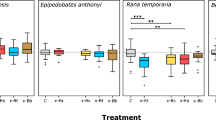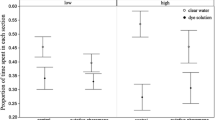Abstract
Organisms from a wide variety of taxonomic groups possess chemical alarm cues that are important in mediating predator avoidance. However, little is known about the presence of such alarm cues in most amphibians, and in particular terrestrial salamanders. In this study we tested whether adult long-toed salamanders (Ambystoma macrodactylum) showed an avoidance response to stimuli from injured conspecifics. Avoidance of stimuli from injured conspecifics could represent avoidance of a chemical alarm cue or, alternatively, avoidance of a territorial pheromone or conspecific predator odor. Consequently, we also tested whether salamanders avoided stimuli from noninjured conspecifics. Salamanders avoided stimuli from injured but not from noninjured conspecifics. Therefore, we concluded that the response to injured conspecifics represents avoidance of a chemical alarm cue and not avoidance of a territorial pheromone or predator cue. This is the first clear demonstration of chemical alarm signaling by a terrestrial amphibian and the first report of chemical alarm signaling in an ambystomatid salamander. By avoiding an area containing stimuli from injured conspecifics, long-toed salamanders may lower their risk of predation by avoiding areas where predators are foraging.
Similar content being viewed by others
References
Appleton, R. D., andPalmer, A. R. 1988. Water-borne stimuli released by predatory crabs and damaged prey induce more predator-resistant shells in a marine gastropod.Proc. Natl. Acad. Sci. U.S.A. 85:4387–4391.
Brodie, E. D., andGibson, L. S. 1969. Defensive behavior and skin glands of the northwestern salamander,Ambystoma gracile. Herpelologica 25:187–194.
Chivers, D. P., andSmith, R. J. F. 1994. Intra- and interspecific avoidance of areas marked with skin extract from brook sticklebacks (Culaea inconstans) in a natural habitat.J. Chem. Ecol. 20:1517–1523.
Chivers, D. P., andSmith, R. J. F. 1995. Fathead minnows (Pimephales promelas) learn to recognize chemical stimuli from high-risk habitats by the presence of alarm substance.Behav. Ecol. 6:155–158.
Chivers, D. P.,Wisenden, B. D., andSmith, R. J. F. 1996. Damselfly larvae learn to recognize predators from chemical cues in the predator's diet.Anim. Behav. In press.
Eible-Eibesfeldt, I. 1949. Über das Vorkommen von Schreckstoffen bei Erdkrötenquappen.Experientia 5:236.
Hazlett, B. A. 1994. Alarm responses in the crayfishOrconectes virilis andOrconectes propinquus.J. Chem. Ecol. 20:1525–1535.
Hews, D. K. 1988. Alarm response in larval western toads,Bufo boreas: release of larval chemicals by a natural predator and its effect on predator capture efficiency.Anim. Behav. 36:125–133.
Hews, D. K., andBlaustein, A. R. 1985. An investigation of the alarm response inBufo boreas andRana cascadae tadpoles.Behav. Neural Biol. 43:47–57.
Hokit, D. G., andBlaustein, A. R. 1996. Predator avoidance and alarm-response behaviour in kindiscriminating tadpoles (Rana cascadae).Ethology. 101:280–290.
Howe, N. R., andSheikh, Y. M. 1975. Anthopleurine: A sea anemone alarm pheromone.Science 189:386–388.
Hrbacek, J. 1950. On the flight reaction of tadpoles of the common toad caused by chemical substances.Experientia 6:100–101.
Jaeger, R. G. 1986. Pheromonal markers as territorial advertisement by terrestrial salamanders, pp. 191–203,in D. Duvall, D. Müller-Schwarze, and R. M. Silverstein (eds.). Chemical Signals in Vertebrates. Plenum Publishing, NY.
Kulzer, E. 1954. Untersuchungen über die Schreckreaktion bei Erdkrötenkaulquappen (Bufo bufo L.).Z. Tierpsychol. 36:443–463.
Lawrence, J. M. 1991. A chemical alarm response inPscnopodia helianthoides (Echinodermata: Asteroidea).Mar. Behav. Physiol. 19:39–44.
Lutterschmidt, W. I., Marvin, G. A., andHutchinson, V. H. 1994. Alarm responses by a plethodontid salamander (Desmognathus ochrophaeus): Conspecific and heterospecific “Schreckstoff.”J. Chem. Ecol. 20:2751–2759.
Marvin, G. A., andHutchison, V. H. 1995. Avoidance response by adult newts (Cynops pyrrhogaster andNotophthalmus viridescens) to chemical alarm cues.Behaviour 132:95–105.
Mason, J. R., Rabin, M. D., andStevens, D. A. 1982. Conditioned taste aversions: Skin secretions used for defense by tiger salamanders.Ambystoma tigrinum. Copeia 1982:667–671.
Parker, D. A., andShulman, M. J. 1986. Avoiding predation: Alarm responses of Caribbean sea urchins to simulated predation on conspecific and heterospecific sea urchins.Mar. Biol. 93:201–208.
Pfeiffer, W. 1966. Die Verbreitung der Schreckreaktion bei Kaulquappen und die Herkunft des Schreckstoffes.Z. Vergl. Physiol. 52:79–98.
Roudebush, R. E., andTaylor, D. H. 1987. Chemical communication between two species of desmognathine salamanders.Copeia 1987:744–748.
Siegel, S., andCastellan, N. J. 1988. Nonparametric Statistics for the Behavioral Sciences, 2nd ed. McGraw-Hill, New York.
Sih, A. 1986. Antipredator responses and the perception of danger by mosquito larvae.Ecology 67:434–441.
Smith, R. J. F. 1992. Alarm signals in fishes.Rev. Fish Biol. Fish. 2:33–63.
Snyder, N. R. F. 1967. An alarm reaction of aquatic gastropods to intraspecific extract. Memoir 403. Cornell University, Agricultural Experiment Station, New York State College of Agriculture, Ithaca, New York, pp. 1–122.
Wilson, D. J., andLefcort, H. 1993. The effect of predator diet on the alarm response of redlegged frog,Rana aurora, tadpoles.Anim. Behav. 46:1017–1019.
Wisenden, B. D., Chivers, D. P., Brown, G. E., andSmith, R. J. F. 1995a. The role of experience in risk assessment: Avoidance of areas chemically labelled with fathead minnow alarm pheromone by conspecifics and heterospecifics.Ecoscience 2:116–122.
Wisenden, B. D., Chivers, D. P., andSmith, R. J. F. 1995b. Early warning in the predation sequence: a disturbance pheromone in Iowa darters (Etheostoma exile).J. Chem. Ecol. 21:1469–1480.
Author information
Authors and Affiliations
Rights and permissions
About this article
Cite this article
Chivers, D.P., Kiesecker, J.M., Anderson, M.T. et al. Avoidance response of a terrestrial salamander (Ambystoma macrodactylum) to chemical alarm cues. J Chem Ecol 22, 1709–1716 (1996). https://doi.org/10.1007/BF02272409
Received:
Accepted:
Issue Date:
DOI: https://doi.org/10.1007/BF02272409




